Abstract
We have recently described hereditary membranoproliferative glomerulonephritis type II in the pig. All affected animals had excessive complement activation, revealed as low plasma C3, elevated plasma terminal complement complex, and massive deposits of complement in the renal glomeruli, and eventually died of renal failure within 11 wk of birth. The aim of the present study was to investigate the cause of complement activation in this disease. Transfusion of normal porcine plasma to affected piglets inhibited complement activation and increased survival. Plasma was successively fractionated and the complement inhibitory effect of each fraction tested in vivo. A single chain 150-kD protein which showed the same complement inhibitory effect as whole plasma was finally isolated. Immunologic cross-reactivity, functional properties, and NH2-terminal sequence identified the protein as factor H. By Western blotting and enzyme immunoassay, membranoproliferative glomerulonephritis-affected piglets were demonstrated to be subtotally deficient in factor H. At 1 wk of age, median (range) factor H concentration was 1.6 mg/liter (1.1-2.3) in deficient animals (n = 13) and 51 mg/liter (26-98) in healthy littermates (n = 52). Our data show that hereditary porcine membrano-proliferative glomerulonephritis type II is caused by factor H deficiency.
Full text
PDF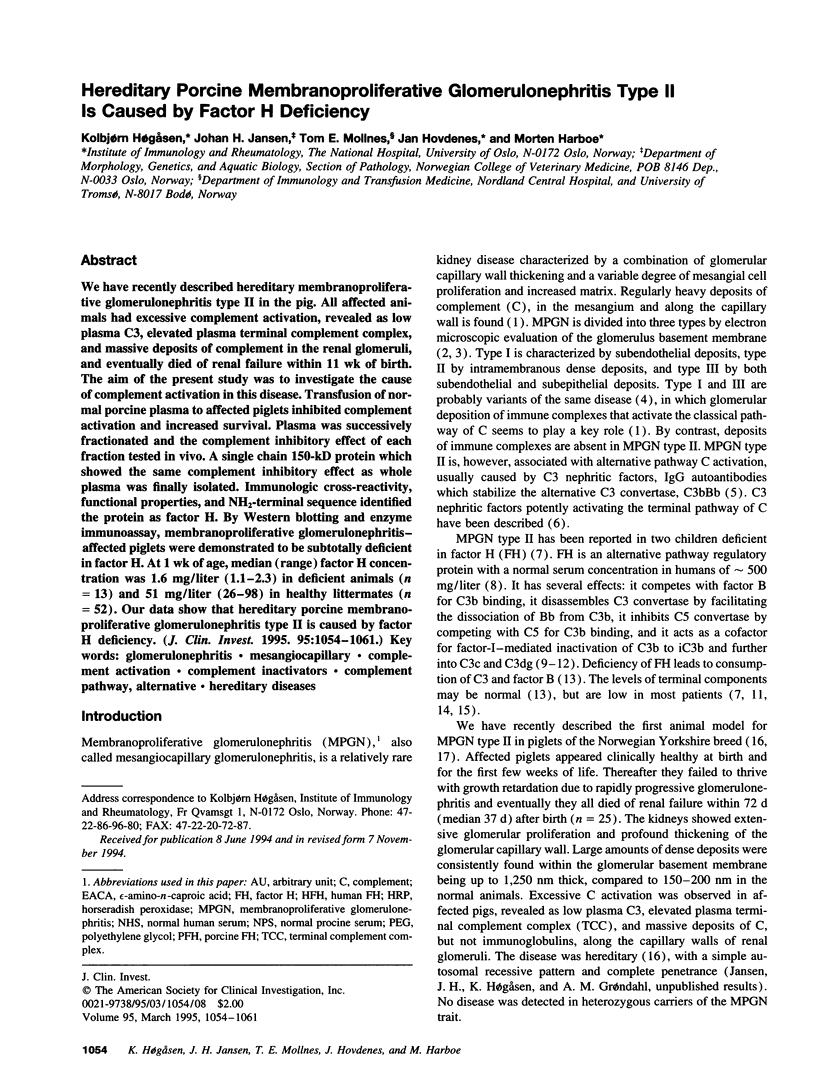
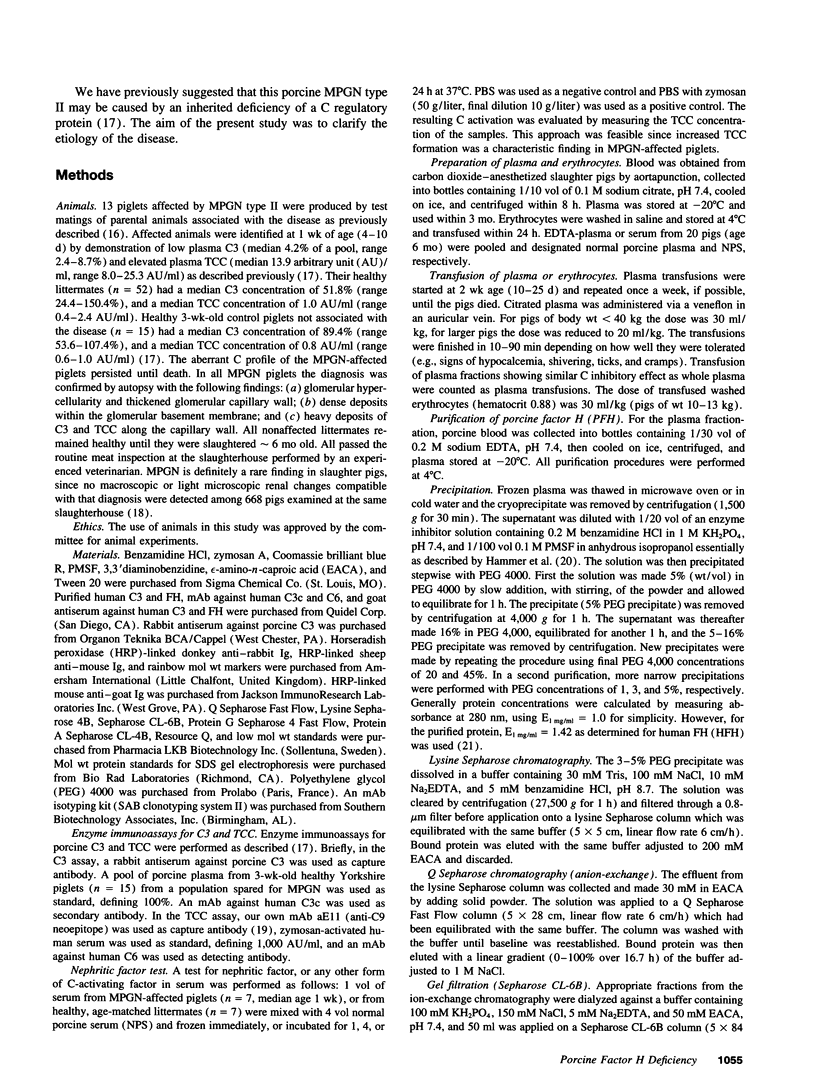
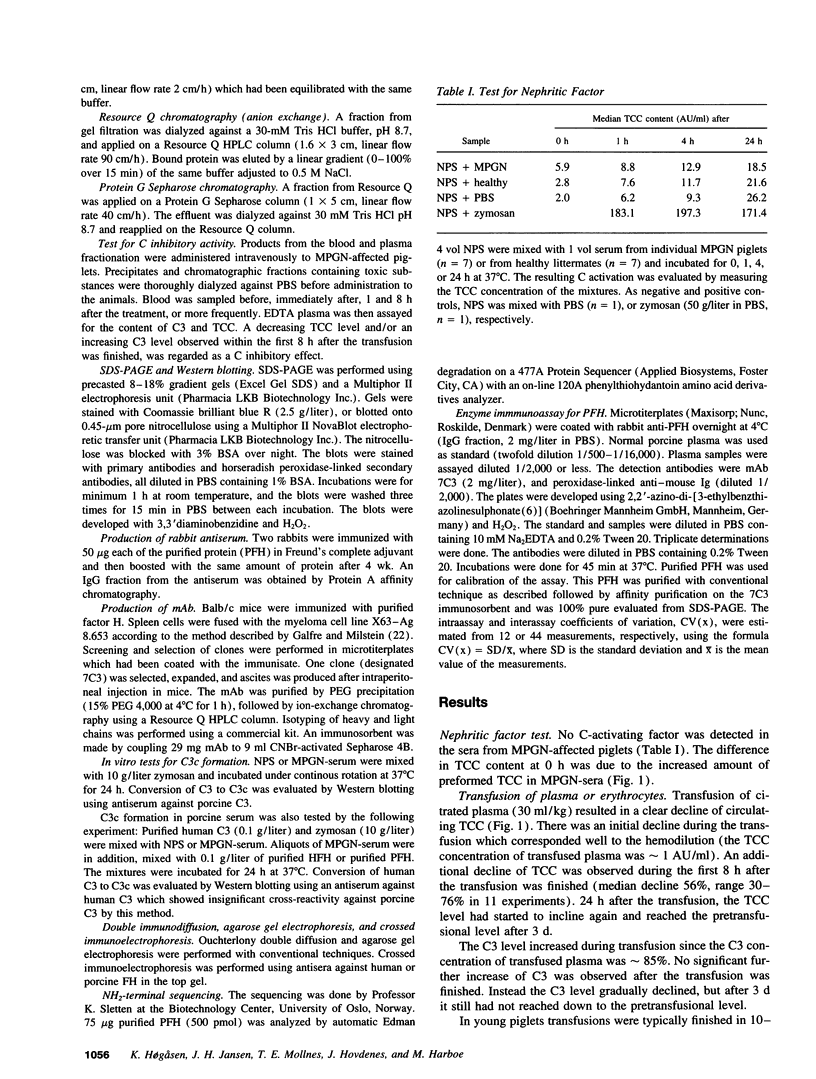
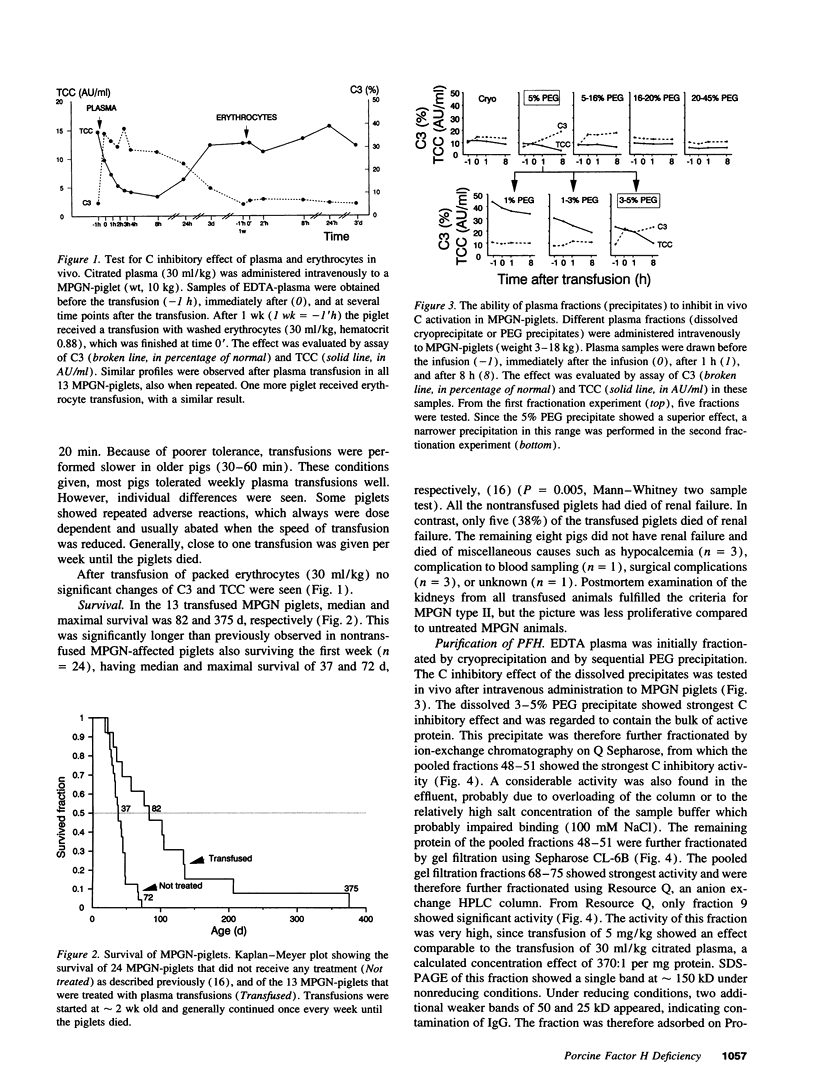
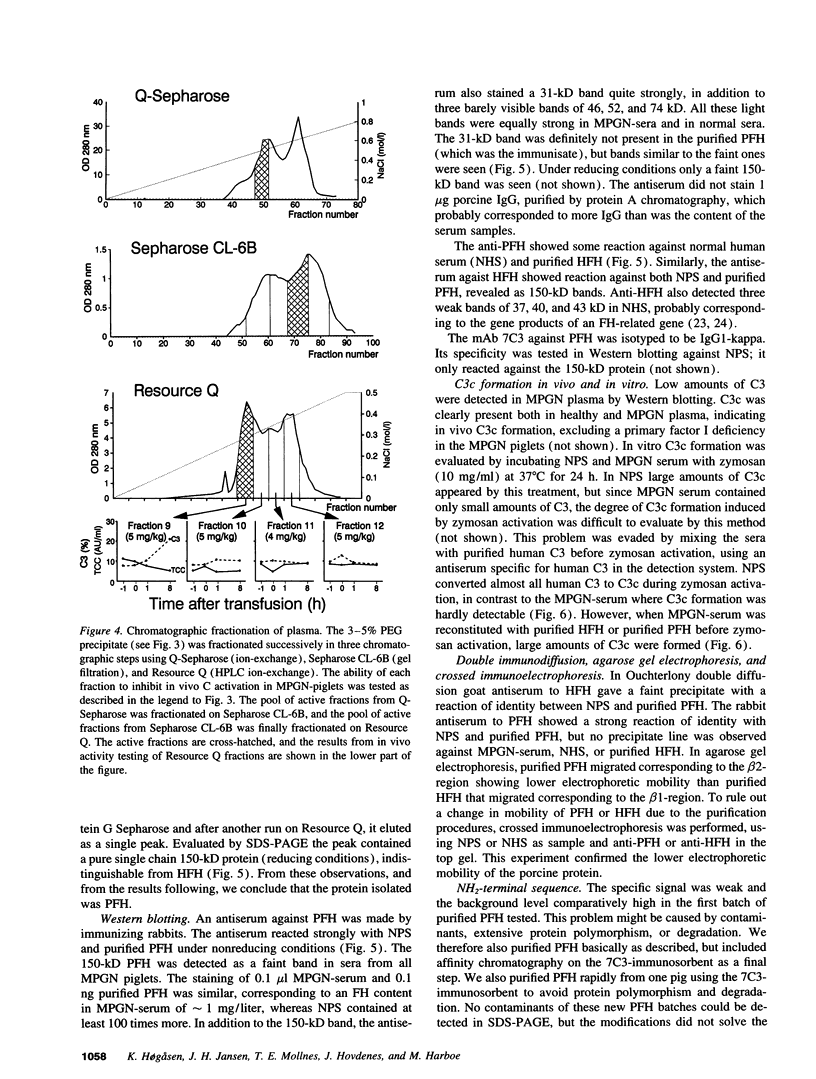
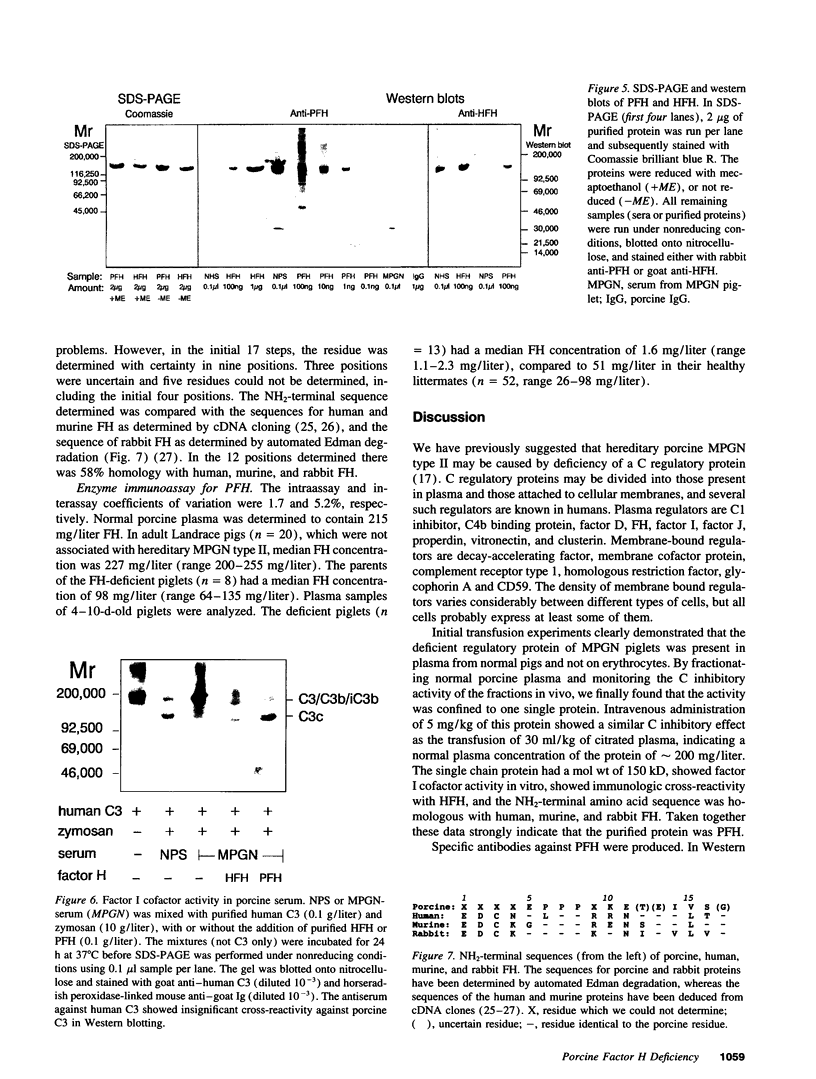
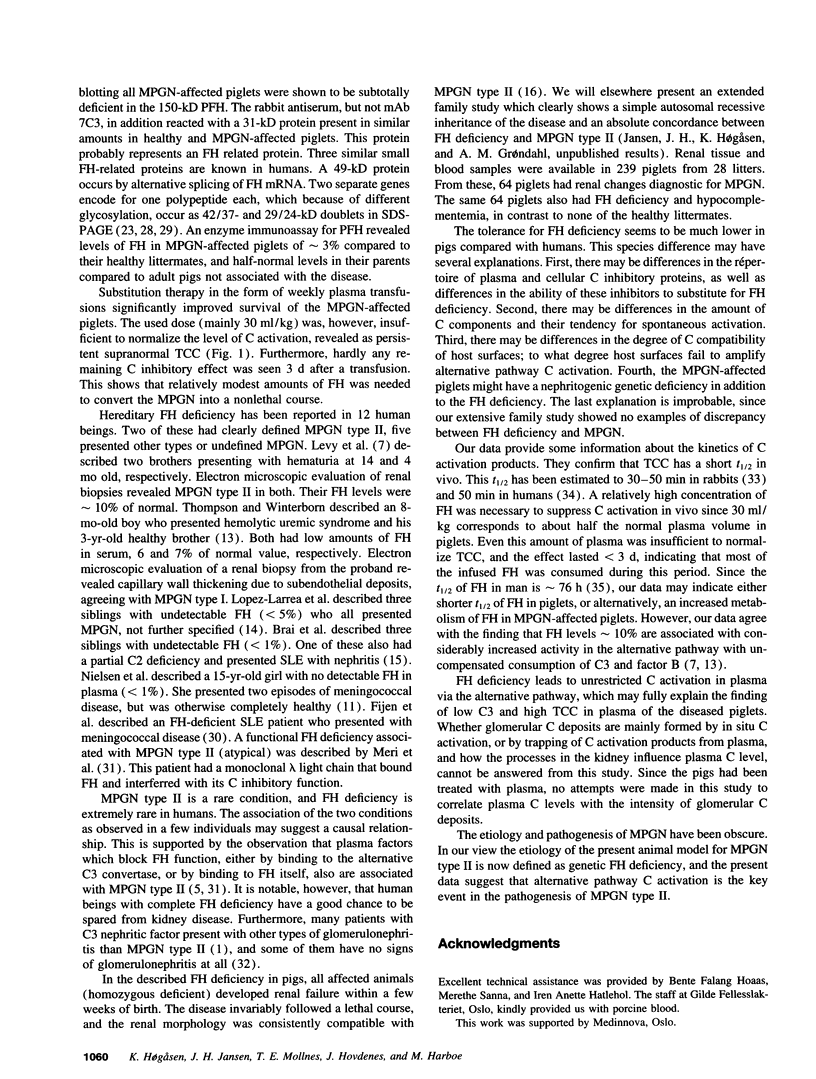
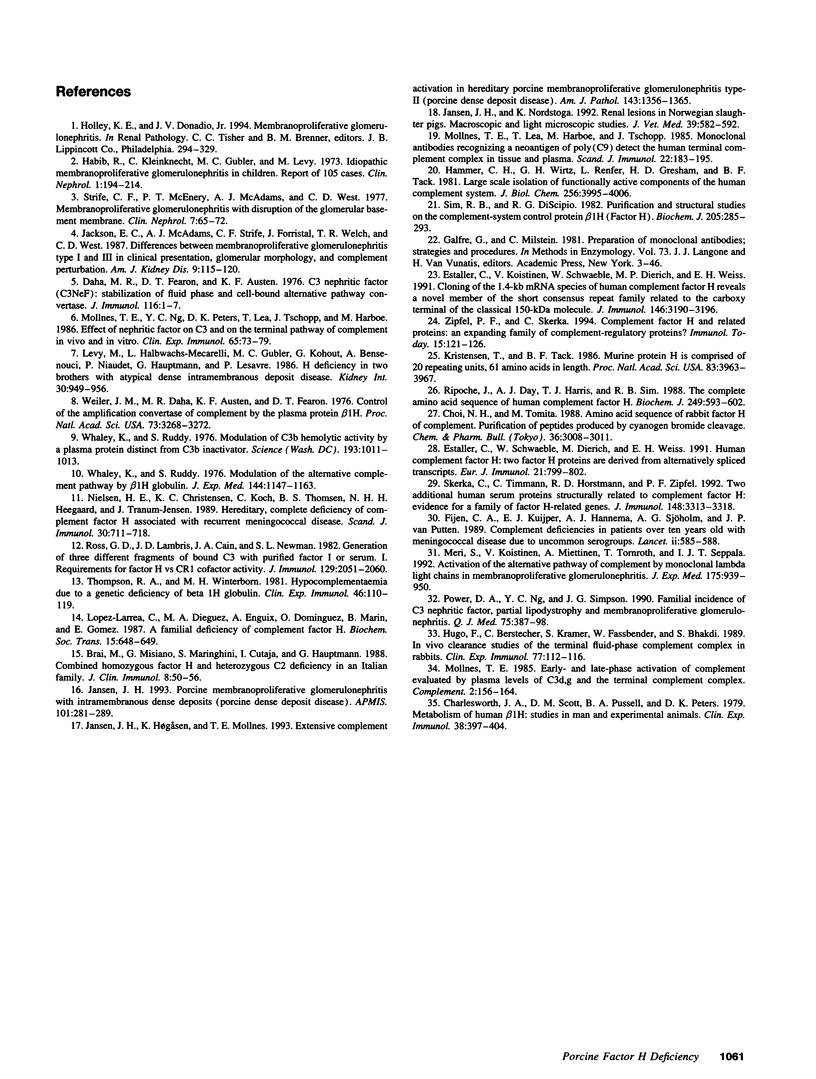
Images in this article
Selected References
These references are in PubMed. This may not be the complete list of references from this article.
- Brai M., Misiano G., Maringhini S., Cutaja I., Hauptmann G. Combined homozygous factor H and heterozygous C2 deficiency in an Italian family. J Clin Immunol. 1988 Jan;8(1):50–56. doi: 10.1007/BF00915156. [DOI] [PubMed] [Google Scholar]
- Charlesworth J. A., Scott D. M., Pussell B. A., Peters D. K. Metabolism of human beta 1H: studies in man and experimental animals. Clin Exp Immunol. 1979 Dec;38(3):397–404. [PMC free article] [PubMed] [Google Scholar]
- Choi N. H., Tomita M. Amino acid sequence of rabbit factor H of complement. Purification of peptides produced by cyanogen bromide cleavage. Chem Pharm Bull (Tokyo) 1988 Aug;36(8):3008–3011. doi: 10.1248/cpb.36.3008. [DOI] [PubMed] [Google Scholar]
- Daha M. R., Fearon D. T., Austen K. F. C3 nephritic factor (C3NeF): stabilization of fluid phase and cell-bound alternative pathway convertase. J Immunol. 1976 Jan;116(1):1–7. [PubMed] [Google Scholar]
- Estaller C., Koistinen V., Schwaeble W., Dierich M. P., Weiss E. H. Cloning of the 1.4-kb mRNA species of human complement factor H reveals a novel member of the short consensus repeat family related to the carboxy terminal of the classical 150-kDa molecule. J Immunol. 1991 May 1;146(9):3190–3196. [PubMed] [Google Scholar]
- Estaller C., Schwaeble W., Dierich M., Weiss E. H. Human complement factor H: two factor H proteins are derived from alternatively spliced transcripts. Eur J Immunol. 1991 Mar;21(3):799–802. doi: 10.1002/eji.1830210337. [DOI] [PubMed] [Google Scholar]
- Fijen C. A., Kuijper E. J., Hannema A. J., Sjöholm A. G., van Putten J. P. Complement deficiencies in patients over ten years old with meningococcal disease due to uncommon serogroups. Lancet. 1989 Sep 9;2(8663):585–588. doi: 10.1016/s0140-6736(89)90712-5. [DOI] [PubMed] [Google Scholar]
- Galfrè G., Milstein C. Preparation of monoclonal antibodies: strategies and procedures. Methods Enzymol. 1981;73(Pt B):3–46. doi: 10.1016/0076-6879(81)73054-4. [DOI] [PubMed] [Google Scholar]
- Habib R., Kleinknecht C., Gubler M. C., Levy M. Idiopathic membranoproliferative glomerulonephritis in children. Report of 105 cases. Clin Nephrol. 1973 Jul-Aug;1(4):194–214. [PubMed] [Google Scholar]
- Hammer C. H., Wirtz G. H., Renfer L., Gresham H. D., Tack B. F. Large scale isolation of functionally active components of the human complement system. J Biol Chem. 1981 Apr 25;256(8):3995–4006. [PubMed] [Google Scholar]
- Hugo F., Berstecher C., Krämer S., Fassbender W., Bhakdi S. In vivo clearance studies of the terminal fluid-phase complement complex in rabbits. Clin Exp Immunol. 1989 Jul;77(1):112–116. [PMC free article] [PubMed] [Google Scholar]
- Jackson E. C., McAdams A. J., Strife C. F., Forristal J., Welch T. R., West C. D. Differences between membranoproliferative glomerulonephritis types I and III in clinical presentation, glomerular morphology, and complement perturbation. Am J Kidney Dis. 1987 Feb;9(2):115–120. doi: 10.1016/s0272-6386(87)80088-4. [DOI] [PubMed] [Google Scholar]
- Jansen J. H., Høgåsen K., Mollnes T. E. Extensive complement activation in hereditary porcine membranoproliferative glomerulonephritis type II (porcine dense deposit disease). Am J Pathol. 1993 Nov;143(5):1356–1365. [PMC free article] [PubMed] [Google Scholar]
- Jansen J. H., Nordstoga K. Renal lesions in Norwegian slaughter pigs. Macroscopic and light microscopic studies. Zentralbl Veterinarmed A. 1992 Oct;39(8):582–592. doi: 10.1111/j.1439-0442.1992.tb00221.x. [DOI] [PubMed] [Google Scholar]
- Jansen J. H. Porcine membranoproliferative glomerulonephritis with intramembranous dense deposits (porcine dense deposit disease). APMIS. 1993 Apr;101(4):281–289. doi: 10.1111/j.1699-0463.1993.tb00112.x. [DOI] [PubMed] [Google Scholar]
- Kristensen T., Tack B. F. Murine protein H is comprised of 20 repeating units, 61 amino acids in length. Proc Natl Acad Sci U S A. 1986 Jun;83(11):3963–3967. doi: 10.1073/pnas.83.11.3963. [DOI] [PMC free article] [PubMed] [Google Scholar]
- Levy M., Halbwachs-Mecarelli L., Gubler M. C., Kohout G., Bensenouci A., Niaudet P., Hauptmann G., Lesavre P. H deficiency in two brothers with atypical dense intramembranous deposit disease. Kidney Int. 1986 Dec;30(6):949–956. doi: 10.1038/ki.1986.278. [DOI] [PubMed] [Google Scholar]
- Meri S., Koistinen V., Miettinen A., Törnroth T., Seppälä I. J. Activation of the alternative pathway of complement by monoclonal lambda light chains in membranoproliferative glomerulonephritis. J Exp Med. 1992 Apr 1;175(4):939–950. doi: 10.1084/jem.175.4.939. [DOI] [PMC free article] [PubMed] [Google Scholar]
- Mollnes T. E. Early- and late-phase activation of complement evaluated by plasma levels of C3d,g and the terminal complement complex. Complement. 1985;2(2-3):156–164. doi: 10.1159/000467856. [DOI] [PubMed] [Google Scholar]
- Mollnes T. E., Lea T., Harboe M., Tschopp J. Monoclonal antibodies recognizing a neoantigen of poly(C9) detect the human terminal complement complex in tissue and plasma. Scand J Immunol. 1985 Aug;22(2):183–195. doi: 10.1111/j.1365-3083.1985.tb01870.x. [DOI] [PubMed] [Google Scholar]
- Mollnes T. E., Ng Y. C., Peters D. K., Lea T., Tschopp J., Harboe M. Effect of nephritic factor on C3 and on the terminal pathway of complement in vivo and in vitro. Clin Exp Immunol. 1986 Jul;65(1):73–79. [PMC free article] [PubMed] [Google Scholar]
- Nielsen H. E., Christensen K. C., Koch C., Thomsen B. S., Heegaard N. H., Tranum-Jensen J. Hereditary, complete deficiency of complement factor H associated with recurrent meningococcal disease. Scand J Immunol. 1989 Dec;30(6):711–718. doi: 10.1111/j.1365-3083.1989.tb02480.x. [DOI] [PubMed] [Google Scholar]
- Power D. A., Ng Y. C., Simpson J. G. Familial incidence of C3 nephritic factor, partial lipodystrophy and membranoproliferative glomerulonephritis. Q J Med. 1990 Apr;75(276):387–398. [PubMed] [Google Scholar]
- Ripoche J., Day A. J., Harris T. J., Sim R. B. The complete amino acid sequence of human complement factor H. Biochem J. 1988 Jan 15;249(2):593–602. doi: 10.1042/bj2490593. [DOI] [PMC free article] [PubMed] [Google Scholar]
- Ross G. D., Lambris J. D., Cain J. A., Newman S. L. Generation of three different fragments of bound C3 with purified factor I or serum. I. Requirements for factor H vs CR1 cofactor activity. J Immunol. 1982 Nov;129(5):2051–2060. [PubMed] [Google Scholar]
- Sim R. B., DiScipio R. G. Purification and structural studies on the complement-system control protein beta 1H (Factor H). Biochem J. 1982 Aug 1;205(2):285–293. doi: 10.1042/bj2050285. [DOI] [PMC free article] [PubMed] [Google Scholar]
- Skerka C., Timmann C., Horstmann R. D., Zipfel P. F. Two additional human serum proteins structurally related to complement factor H. Evidence for a family of factor H-related genes. J Immunol. 1992 May 15;148(10):3313–3318. [PubMed] [Google Scholar]
- Strife C. F., McEnery P. T., McAdams A. J., West C. D. Membranoproliferative glomerulonephritis with disruption of the glomerular basement membrane. Clin Nephrol. 1977 Feb;7(2):65–72. [PubMed] [Google Scholar]
- Thompson R. A., Winterborn M. H. Hypocomplementaemia due to a genetic deficiency of beta 1H globulin. Clin Exp Immunol. 1981 Oct;46(1):110–119. [PMC free article] [PubMed] [Google Scholar]
- Weiler J. M., Daha M. R., Austen K. F., Fearon D. T. Control of the amplification convertase of complement by the plasma protein beta1H. Proc Natl Acad Sci U S A. 1976 Sep;73(9):3268–3272. doi: 10.1073/pnas.73.9.3268. [DOI] [PMC free article] [PubMed] [Google Scholar]
- Whaley K., Ruddy S. Modulation of C3b hemolytic activity by a plasma protein distinct from C3b inactivator. Science. 1976 Sep 10;193(4257):1011–1013. doi: 10.1126/science.948757. [DOI] [PubMed] [Google Scholar]
- Whaley K., Ruddy S. Modulation of the alternative complement pathways by beta 1 H globulin. J Exp Med. 1976 Nov 2;144(5):1147–1163. doi: 10.1084/jem.144.5.1147. [DOI] [PMC free article] [PubMed] [Google Scholar]
- Zipfel P. F., Skerka C. Complement factor H and related proteins: an expanding family of complement-regulatory proteins? Immunol Today. 1994 Mar;15(3):121–126. doi: 10.1016/0167-5699(94)90155-4. [DOI] [PubMed] [Google Scholar]




